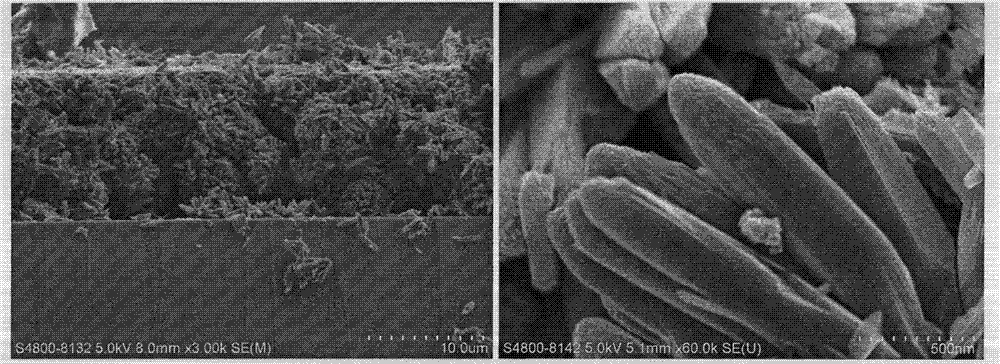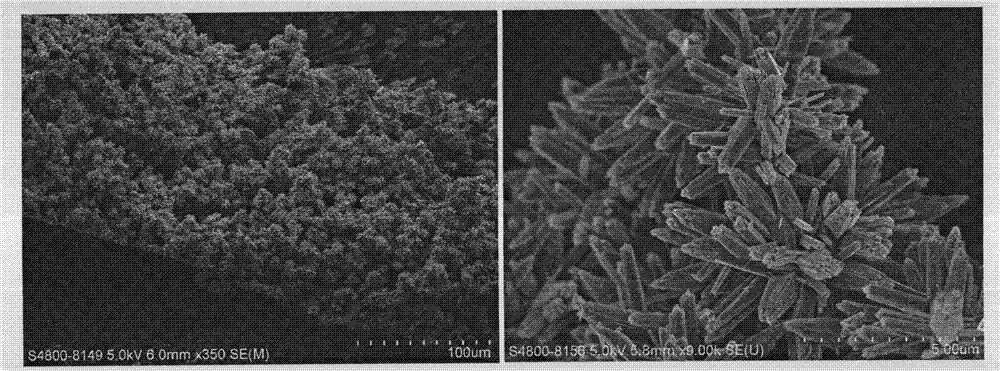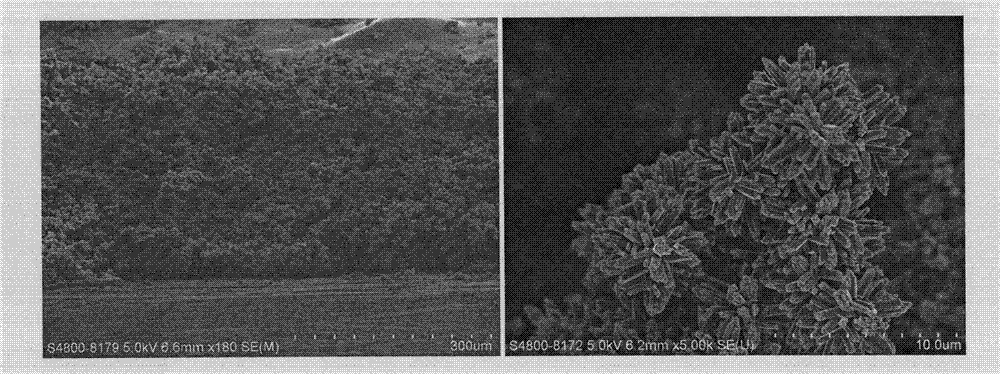Preparation method of titanium oxide nanoflower film
A titanium dioxide and nanoflower technology, applied in the directions of titanium dioxide, titanium oxide/hydroxide, nanotechnology, etc., can solve the problems of high pollution, heavy metal ion environmental pollution, difficulty in large-scale production, etc., and achieve strong photocatalytic activity and preparation method. Simple, novel structure
- Summary
- Abstract
- Description
- Claims
- Application Information
AI Technical Summary
Problems solved by technology
Method used
Image
Examples
Embodiment 1
[0024] Add 1mL of tetrabutyl titanate, 15mL of concentrated hydrochloric acid, and 15mL of deionized water into a 50mL reaction kettle with a polytetrafluoroethylene liner and mix evenly, then place the cleaned FTO conductive glass with a size of 1.5×3.5cm on an incline In the reaction solution, the reaction vessel was sealed and placed at 180° C. for 1 hour to react. After the reaction is finished, the product is washed and dried to prepare a titanium dioxide nanoflower film.
[0025] figure 1 It is a field emission scanning electron microscope image of the titanium dioxide nanoflower film prepared in Example 1 of the present invention. It can be seen from the cross-sectional view that the thickness of the film is about 15 μm, and the film is constructed of clusters of titanium dioxide nanoflowers. Each nanoflower is composed of petals with a length of about 1.5 μm and a width of about 450 nm.
Embodiment 2
[0027] Add 1mL of tetrabutyl titanate, 15mL of concentrated hydrochloric acid, and 15mL of deionized water into a 50mL reaction kettle with a polytetrafluoroethylene liner and mix evenly, then place the cleaned FTO conductive glass with a size of 1.5×3.5cm on an incline In the reaction solution, the reaction vessel was sealed and placed at 180° C. for 4 hours. After the reaction is finished, the product is washed and dried to prepare a titanium dioxide nanoflower film.
[0028] figure 2 It is a field emission scanning electron microscope image of the titanium dioxide nanoflower film prepared in Example 2 of the present invention. It can be seen from the cross-sectional view that the thickness of the film is about 160 μm, and the film is constructed of clusters of titanium dioxide nanoflowers. Each nanoflower is composed of petals with a length of about 1.9 μm and a width of about 400 nm.
Embodiment 3
[0030] Add 1mL of tetrabutyl titanate, 15mL of concentrated hydrochloric acid, and 15mL of deionized water into a 50mL reaction kettle with a polytetrafluoroethylene liner and mix evenly, then place the cleaned FTO conductive glass with a size of 1.5×3.5cm on an incline In the reaction solution, the reaction vessel was sealed and placed at 180° C. for 24 hours. After the reaction is finished, the product is washed and dried to prepare a titanium dioxide nanoflower film.
[0031] image 3 It is the field emission scanning electron microscope image of the titanium dioxide nanoflower film prepared in Example 3 of the present invention. It can be seen from the cross-sectional view that the thickness of the film is about 300 μm, and the film is constructed of clusters of titanium dioxide nanoflowers. Each nanoflower is composed of petals with a length of about 1.3 μm and a width of about 380 nm.
PUM
| Property | Measurement | Unit |
|---|---|---|
| thickness | aaaaa | aaaaa |
| length | aaaaa | aaaaa |
| width | aaaaa | aaaaa |
Abstract
Description
Claims
Application Information
 Login to View More
Login to View More - R&D
- Intellectual Property
- Life Sciences
- Materials
- Tech Scout
- Unparalleled Data Quality
- Higher Quality Content
- 60% Fewer Hallucinations
Browse by: Latest US Patents, China's latest patents, Technical Efficacy Thesaurus, Application Domain, Technology Topic, Popular Technical Reports.
© 2025 PatSnap. All rights reserved.Legal|Privacy policy|Modern Slavery Act Transparency Statement|Sitemap|About US| Contact US: help@patsnap.com



